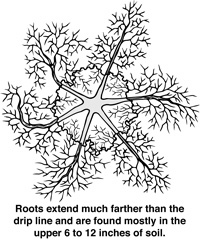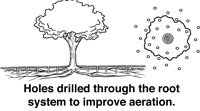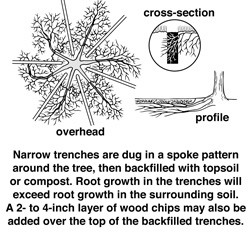
" He who plants a tree is a true friend of Nature. He provides a gift for many generations and the shaded smiling faces that he will never see shall bless him. "
~Glenn Sawtell, Arborist
Improving Aeration of the Root Zone
Drilling Holes/Vertical Mulching
 Perfect soil should be very porous, more than just "good dirt". It should contain large, water holding objects such as bark, porous rocks, small twigs, or a commercial soil additive such as perlite or vermiculite. These help the soil retain water, which is rich in oxygen (I will explain, later, a simple method to super enrich your water with oxygen). Other ingredients that hold vast amounts of water are manure, peat moss, dried grass clippings, and leaves. These ingredients can be combined with sand to make an all around, partially self-fertilizing soil. More often than not mature trees in an urban environment do not enjoy the luxury of perfect soil and the root system can find itself under constant attack from soil compaction and it is easily overlooked. Increases in soil levels, vehicular compaction and construction can all cause a significant depletion of oxygen to tree roots. Soil aeration is a relatively simple and effective way to improve root growth and water uptake.
Perfect soil should be very porous, more than just "good dirt". It should contain large, water holding objects such as bark, porous rocks, small twigs, or a commercial soil additive such as perlite or vermiculite. These help the soil retain water, which is rich in oxygen (I will explain, later, a simple method to super enrich your water with oxygen). Other ingredients that hold vast amounts of water are manure, peat moss, dried grass clippings, and leaves. These ingredients can be combined with sand to make an all around, partially self-fertilizing soil. More often than not mature trees in an urban environment do not enjoy the luxury of perfect soil and the root system can find itself under constant attack from soil compaction and it is easily overlooked. Increases in soil levels, vehicular compaction and construction can all cause a significant depletion of oxygen to tree roots. Soil aeration is a relatively simple and effective way to improve root growth and water uptake.
A common method of aeration of the root zone involves drilling holes in the ground. Holes are usually 2 to 4 inches in diameter and are made about 1 metre from the trunk of the tree and throughout the root zone of the tree. The depth should be at least 12 inches but may need to be deeper if the soil grade has been raised. Sometimes the holes are filled with peat moss, wood chips, pea gravel, or other materials that maintain aeration and support root growth. This process is called vertical mulching. If a drill bit of this diameter cannot be obtained. A pitch  fork can be used to allow air down to the root system. Simply drive the pitch fork into the soil as far as possible by treading on it or striking the tines with a heavy object such as a sledge hammer. Carefully rock the fork back and forth to release the fork from the soil. Avoid excessive disturbance to the roots and do not attempt to pry the root system up with the fork. Repeat at intervals of approximately 40cm around and outside the drip zone of the tree. Due to smaller size of these holes, they can be left open rather than filled.
fork can be used to allow air down to the root system. Simply drive the pitch fork into the soil as far as possible by treading on it or striking the tines with a heavy object such as a sledge hammer. Carefully rock the fork back and forth to release the fork from the soil. Avoid excessive disturbance to the roots and do not attempt to pry the root system up with the fork. Repeat at intervals of approximately 40cm around and outside the drip zone of the tree. Due to smaller size of these holes, they can be left open rather than filled.
 Radial Aeration
More recent research has shown promising results with another method of aeration called radial aeration. Narrow trenches are cut with a compressed air gun or a mattock in a radial pattern throughout the root zone. These trenches appear similar to the spokes of a wagon wheel. It is important to begin the trenches 4 to 8 feet from the trunk of the tree to avoid cutting any major support roots. The trenches should extend at least as far as the drip line of the tree. If the primary goal is to reduce compaction, the trenches should be about 8 to 12 inches in depth. They may need to be deeper if the soil grade has been raised.
Radial Aeration
More recent research has shown promising results with another method of aeration called radial aeration. Narrow trenches are cut with a compressed air gun or a mattock in a radial pattern throughout the root zone. These trenches appear similar to the spokes of a wagon wheel. It is important to begin the trenches 4 to 8 feet from the trunk of the tree to avoid cutting any major support roots. The trenches should extend at least as far as the drip line of the tree. If the primary goal is to reduce compaction, the trenches should be about 8 to 12 inches in depth. They may need to be deeper if the soil grade has been raised.
The narrow trenches can be backfilled with topsoil or compost. Root growth will be greater in the trenched area than in the surrounding soil. This treatment can give a tree the added boost it needs to adapt to the compacted soil or new grade. Vertical mulching and radial trenching are techniques that may improve conditions for root growth. If construction-damaged trees are to survive the injuries and stresses they have suffered, they must replace the roots that have been lost.
Super-enriching your water with oxygen.
Super-enriching your water with oxygen is a very simple process. All it requires is adding ½ litre of hydrogen peroxide to 10 litres of water, shake well (vigorously for about five(5) seconds), and allow it to sit over night. The reason this enriches the water with oxygen is simple. Water is two hydrogen atoms and one oxygen atom, H2O. Hydrogen peroxide is H2O2, or water with an extra atom of oxygen. When H2O2 is added to H2O, the extra atom in the hydrogen peroxide attaches itself to bacteria and impurities in the water, thereby disinfecting it. After most impurities have been eliminated, you are left with a water-hydrogen peroxide mix. When added to your plants the extra oxygen in the hydrogen peroxide attaches to the roots, helps increase nutrient uptake, and increases plant growth by 30%.